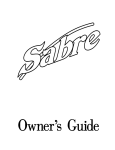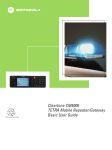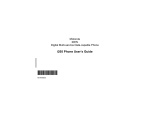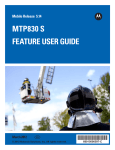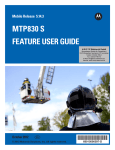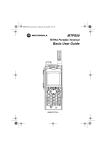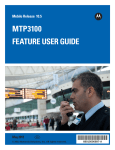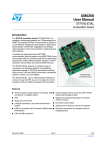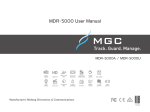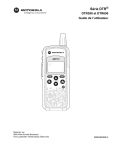Download User guide Motorola CEP400 TETRA radio
Transcript
CEP400 TETRA Portable Terminal Basic User Guide Bedienungsanleitung Guide d'utilisation Guía básica del usuario Algemene gebruikershandleiding EN DE FR ES NL 109-A 00109@ When printed by Motorola 21 1 20 2 3 19 4 17b 5 18 6 17a 16 MENU 15 7 14 8 13 9 12 10 11 Safety Information . . . . . . . . . . . . . . . . . . . . . . . . . . . . . 4 Disposal Information . . . . . . . . . . . . . . . . . . . . . . . . . . . . . . . . . Copyright Information . . . . . . . . . . . . . . . . . . . . . . . . . . . . . . . . Icon Conventions . . . . . . . . . . . . . . . . . . . . . . . . . . . . . . . . . . . 4 4 5 CEP400 Overview . . . . . . . . . . . . . . . . . . . . . . . . . . . . . . 6 Controls and Indicators . . . . . . . . . . . . . . . . . . . . . . . . . . . . . . . Audio Signal Tones . . . . . . . . . . . . . . . . . . . . . . . . . . . . . . . . . . Periodic Alert . . . . . . . . . . . . . . . . . . . . . . . . . . . . . . . . . . . Key, Knob, and Button Overview . . . . . . . . . . . . . . . . . . . . . . . On-Off/End/Home Key . . . . . . . . . . . . . . . . . . . . . . . . . . . Soft Keys . . . . . . . . . . . . . . . . . . . . . . . . . . . . . . . . . . . . . . Menu Key . . . . . . . . . . . . . . . . . . . . . . . . . . . . . . . . . . . . . Rotary Knob . . . . . . . . . . . . . . . . . . . . . . . . . . . . . . . . . . . Emergency Button . . . . . . . . . . . . . . . . . . . . . . . . . . . . . . Function Keys . . . . . . . . . . . . . . . . . . . . . . . . . . . . . . . . . . Speaker Control Key . . . . . . . . . . . . . . . . . . . . . . . . . . . . . Volume Adjustment Mode . . . . . . . . . . . . . . . . . . . . . . . . . Audio Profile . . . . . . . . . . . . . . . . . . . . . . . . . . . . . . . . . . . Howling Suppression . . . . . . . . . . . . . . . . . . . . . . . . . . . . The LED Status Indicator . . . . . . . . . . . . . . . . . . . . . . . . . . . . . To Enter the Menu Items . . . . . . . . . . . . . . . . . . . . . . . . . . . . . . To Return to the Previous Level . . . . . . . . . . . . . . . . . . . . . . . . To Exit the Menu Items . . . . . . . . . . . . . . . . . . . . . . . . . . . . . . . List of Menu Items . . . . . . . . . . . . . . . . . . . . . . . . . . . . . . . . . . . The Display . . . . . . . . . . . . . . . . . . . . . . . . . . . . . . . . . . . . . . . . Status Icons . . . . . . . . . . . . . . . . . . . . . . . . . . . . . . . . . . . Menu Icons . . . . . . . . . . . . . . . . . . . . . . . . . . . . . . . . . . . . Inbox Icons . . . . . . . . . . . . . . . . . . . . . . . . . . . . . . . . . . . . Contact Icons . . . . . . . . . . . . . . . . . . . . . . . . . . . . . . . . . . Outbox Icons . . . . . . . . . . . . . . . . . . . . . . . . . . . . . . . . . . . 6 8 10 10 10 11 11 11 11 12 13 13 13 13 14 14 14 14 15 18 18 20 20 21 21 1 English Contents Getting Started . . . . . . . . . . . . . . . . . . . . . . . . . . . . . . . . 22 English Battery . . . . . . . . . . . . . . . . . . . . . . . . . . . . . . . . . . . . . . . . . . . . Installing the Battery . . . . . . . . . . . . . . . . . . . . . . . . . . . . . Replacing the Battery . . . . . . . . . . . . . . . . . . . . . . . . . . . . Charging the Battery . . . . . . . . . . . . . . . . . . . . . . . . . . . . . Battery Capacity Information . . . . . . . . . . . . . . . . . . . . . . . Attaching the Antenna . . . . . . . . . . . . . . . . . . . . . . . . . . . . Powering On/Off (On-Off/End/Home Key) . . . . . . . . . . . . . . . . Powering On (Emergency Button) . . . . . . . . . . . . . . . . . . . . . . Powering On with Transmit Inhibit (TXI) Active . . . . . . . . . . . . . Unlocking the CEP400 . . . . . . . . . . . . . . . . . . . . . . . . . . . . . . . Locking/Unlocking the Keypad . . . . . . . . . . . . . . . . . . . . . . . . . 22 22 22 23 23 24 24 24 24 25 25 Selecting TMO or DMO Operation . . . . . . . . . . . . . . . . . 26 Entering TMO or DMO . . . . . . . . . . . . . . . . . . . . . . . . . . . . . . . 26 Group Calls . . . . . . . . . . . . . . . . . . . . . . . . . . . . . . . . . . . 27 Favorite Folders . . . . . . . . . . . . . . . . . . . . . . . . . . . . . . . . . . . . Selecting the “My Groups” Folders . . . . . . . . . . . . . . . . . . Adding a Group (TMO/DMO) . . . . . . . . . . . . . . . . . . . . . . Deleting a Group (TMO/DMO) . . . . . . . . . . . . . . . . . . . . . Deleting Favorite Folder . . . . . . . . . . . . . . . . . . . . . . . . . . Selecting a Group . . . . . . . . . . . . . . . . . . . . . . . . . . . . . . . . . . . Using the Rotary Knob . . . . . . . . . . . . . . . . . . . . . . . . . . . Using the Navigation Key . . . . . . . . . . . . . . . . . . . . . . . . . Using Alphabetic Search . . . . . . . . . . . . . . . . . . . . . . . . . . Using Folder Search . . . . . . . . . . . . . . . . . . . . . . . . . . . . . Selecting a Folder . . . . . . . . . . . . . . . . . . . . . . . . . . . . . . . . . . . TMO Group Calls . . . . . . . . . . . . . . . . . . . . . . . . . . . . . . . . . . . Making a TMO Group Call . . . . . . . . . . . . . . . . . . . . . . . . Receiving a TMO Group Call . . . . . . . . . . . . . . . . . . . . . . Receiving a TMO Broadcast Call . . . . . . . . . . . . . . . . . . . DMO Group Calls . . . . . . . . . . . . . . . . . . . . . . . . . . . . . . . . . . . Making a DMO Group Call . . . . . . . . . . . . . . . . . . . . . . . . Receiving a DMO Group Call . . . . . . . . . . . . . . . . . . . . . . Exiting DMO . . . . . . . . . . . . . . . . . . . . . . . . . . . . . . . . . . . 2 27 27 27 27 28 28 28 28 28 28 29 29 29 29 29 30 30 30 30 Creating a Contact . . . . . . . . . . . . . . . . . . . . . . . . . . . . . . . . . . How to Dial . . . . . . . . . . . . . . . . . . . . . . . . . . . . . . . . . . . . . . . . Dialing a Number . . . . . . . . . . . . . . . . . . . . . . . . . . . . . . . Dialing via the Contact List . . . . . . . . . . . . . . . . . . . . . . . . Private Call . . . . . . . . . . . . . . . . . . . . . . . . . . . . . . . . . . . . . . . . Making a Private Call . . . . . . . . . . . . . . . . . . . . . . . . . . . . Receiving a Private Call . . . . . . . . . . . . . . . . . . . . . . . . . . Phone and PABX Calls . . . . . . . . . . . . . . . . . . . . . . . . . . . . . . . Making a Phone or PABX Call . . . . . . . . . . . . . . . . . . . . . 31 31 31 32 32 32 33 33 33 Emergency Mode . . . . . . . . . . . . . . . . . . . . . . . . . . . . . . 34 Entering or Exiting Emergency Mode . . . . . . . . . . . . . . . . . . . . Sending an Emergency Alarm . . . . . . . . . . . . . . . . . . . . . . . . . Hot Microphone Feature . . . . . . . . . . . . . . . . . . . . . . . . . . . . . . Making an Emergency Group Call . . . . . . . . . . . . . . . . . . . . . . Silent Emergency Mode . . . . . . . . . . . . . . . . . . . . . . . . . . . . . . 34 34 35 36 36 Messages . . . . . . . . . . . . . . . . . . . . . . . . . . . . . . . . . . . . 37 Sending a Status Message . . . . . . . . . . . . . . . . . . . . . . . . . . . . Sending a User-defined Message . . . . . . . . . . . . . . . . . . . . . . . Sending a Predefined Message . . . . . . . . . . . . . . . . . . . . . . . . Handling New Incoming Text Messages . . . . . . . . . . . . . . . . . . Handling Unread (New) Messages . . . . . . . . . . . . . . . . . . . . . . 37 37 37 37 38 Tips & Tricks . . . . . . . . . . . . . . . . . . . . . . . . . . . . . . . . . . 39 Quick Reference Guide . . . . . . . . . . . . . . . . . . . . . . . . . 43 © Motorola Inc., 2009 MOTOROLA and the stylized M Logo are registered in the U.S. Patent and Trademark Office. All other product or service names are the property of their respective owners. 3 English Private, Phone, and PABX Calls . . . . . . . . . . . . . . . . . . 31 Safety Information English Before using these products, read the operating instructions for safe usage contained in the Product Safety and RF Exposure booklet 6864117B25. The CEP400 is restricted to occupational use only to satisfy ICNIRP RF energy exposure requirements. Before using the products, read the RF energy awareness information and operating instructions in the Product Safety and RF Exposure booklet (Motorola Publication part number 6864117B25) to ensure compliance with RF energy exposure limits. Keep this User Guide and the Product Safety and RF Exposure booklet in a safe place and make it available to other operators in case the accessories are passed on to other people. Disposal Information The European Union Waste of Electrical and Electronic Equipment directive requires that products sold into EU countries must have the crossed out trashbin label on the product (or the package in some cases). As defined by the WEEE directive, this cross-out trashbin label means that customers and end-users in EU countries should not dispose of electronic and electrical equipment or accessories in household waste. Customers or end-users in EU countries should contact their local equipment supplier representative or service centre for information about the waste collection system in their country. Copyright Information The Motorola products described in this manual may include copyrighted Motorola computer programs stored in semiconductor memories or other mediums. Laws in the United States and other countries preserve for Motorola certain exclusive rights for copyrighted computer programs, but not limited to, including the exclusive right to copy or reproduce in any form the copyrighted computer program. 4 This document is copyright protected. Duplications for the purpose of the use of Motorola products are permitted to an appropriate extent. Duplications for other purposes, changes, additions or other processing of this document are not permitted. Only this electronically-saved document is considered to be the original. Duplications are considered merely copies. Motorola, Inc., and its subsidiaries and affiliates do not vouch for the correctness of such kinds of copies. Icon Conventions The document set is designed to give the reader more visual cues. The following graphic icons are used throughout the documentation set. These icons and their associated meanings are described below. The signal word Warning with the associated safety icon implies information that, if disregarded, could result in death or serious injury, or serious product damage. The signal word Caution with the associated safety icon implies information that, if disregarded, may result in minor or moderate injury, or serious product damage. The signal word Caution may be used without the safety icon to state potential damage or injury that is not related to the product. Notes contain information more important than the surrounding text, such as exceptions or preconditions. They also refer the reader elsewhere for additional information, remind the reader how to complete an action (when it’s not part of the current procedure, for instance), or tell the reader where something is located on the screen. There is no warning level associated with a Note. 5 English Accordingly, any copyrighted Motorola computer programs contained in the Motorola products described in this manual may not be copied, reproduced, modified, reverse-engineered, or distributed in any manner without the express written permission of Motorola. Furthermore, the purchase of Motorola products shall not be deemed to grant either directly or by implication, estoppel, or otherwise, any licence under the copyrights, patents, or patent applications of Motorola, except for the normal non-exclusive licence to use that arises by operation of the law in the sale of a product. CEP400 Overview English Controls and Indicators The numbers below refer to the illustration on the inside front cover. Number Description 1 Antenna 2 LED (Indicator) 3 Top Microphone Activated during Simplex, high-audio calls such as Group Calls. External Antenna Connector 4 5 6 Used with the digital car kit to connect the RF signal to the external antenna. (At the back of the CEP400) Grayscale Display * Provides alphanumeric text and images within 130 x 130 pixels with backlight, scalable fonts, and contrast. Menu Key Used to enter the main menu and the context sensitive menu. On-Off/End/Home Key 7 8 Audio Accessory Connector 9 Sensor for keypad backlight On/Off 10 11 12 13 6 • Press and hold to turn the CEP400 On/Off. • Press to end calls. • Press to return to the Home display (idle screen). (At the side of the CEP400) Bottom Microphone Activated during Simplex and Duplex, low-audio calls such as Phone Calls. Accessory Connector Provides connection for accessories. (At the base of the CEP400) Speaker Control Key Selects earpiece (low audio), PHF (low audio) or speaker (high audio). Speaker Number Description Four Way Navigation Key 15 16 Press up, down, left or right for list scrolling, while moving around the menu hierarchy, or for alphanumeric text editing. You can enter digits using the Navigation Up and Downs keys. English 14 Send Key Used to initiate or answer Duplex calls (such as Phone Calls), or send status and text messages. Soft Key(s) Press to select the option that appears in the display directly above the left or right soft key. Programmable Side Keys 1 and 2 17 Default programming: upper Side key activates/deactivates Backlight; lower Side key activates Screen Saver. (See also No. 19) Push-To-Talk Button (PTT) 18 Press and hold this side button to talk in Simplex calls, release it to listen. Press to send status and text messages. 19 Earpiece Programmable Rotary Knob 20 Default programming: “Dual” – Press the knob to toggle between “volume” and “list”. Side keys (No. 17) operate as programmed. You can enter digits using the Rotary Knob. Emergency Button (on top of the CEP400) 21 Press and hold to enter Emergency Mode, and send Emergency Alarms (as programmed). When the CEP400 is Off, press and hold to power on in Emergency Mode or in normal mode (as programmed). *) Color display is available on your CEP400 as a software orderable feature. Before using your CEP400 for the first time, remove the plastic lens protector from the display, and charge the battery overnight to ensure battery is initialised to its full capacity. Take care to clean the bottom connector frequently and particularly prior to the programming procedure e.g. with a soft brush (do not use fluids). 7 Audio Signal Tones = High Tone; Description = Low Tone; Type Repeated English Idle • Back to Home display • Back to rotary volume use when rotary scroll timer expires • Back to coverage • Back to full service Once Clear to send Once Bad key press Once • Good key press • CEP400 self-test fails at power up • From out-of-service to in-service Once In Call Call clear warning Once Call waiting tone while Phone or Private Call are pending. Every 6 seconds, until a call is terminated Data connected or Data disconnected Once Once (Normal Tone) Talk Permit sounds upon pressing the PTT Once (Short Tone) Talk permit without gateway sounds upon pressing PTT. The tone indicates the gateway is no longer available • • • • 8 Talk prohibit System busy Time-out timer expire Called CEP400 not available or busy Twice Once Until you release the PTT. Type Repeated Once Wrong number dialed No tone DMO (Direct Mode) Entering Once DMO Exiting Once Local site trunking — Entering/Exiting Once Phone ring back (sending) Every three seconds, until the called user answers or call is rejected Phone busy Every 0.5 seconds Status message sent to the dispatcher or failed Twice English Description Call disconnected or failed due to network Incoming Calls Status message acknowledged by the dispatcher Four times Your CEP400 received a Group Call without gateway (setup only) Once High-priority Group Call received Once Emergency Alarm sent or received Twice Emergency Alarm failed Four times Emergency Call received Once Phone ring, Duplex Private Call (reception) According to the Ring Style Until you answer or sub-menu setting. the call is rejected Private Call received According to the Ring Style Until you answer or sub-menu setting. the call is rejected Private Call ringing to the caller Until the call is answered 9 Description Type Repeated English Simplex Private Pre-emptive Priority Call (PPC) ring Every 4 seconds, until the call is answered or rejected. Duplex Private PPC ring Every 4 seconds, until the call is answered or rejected. Limited service Once, upon entering limited service. New mail received Once New Group Call Once General Volume setting (earpiece, keypad, speaker) Continuous Volume setting (ringer) While setting the volume. Transmit Inhibit (TXI) Once Periodic Alert Periodic alert indicates the missed calls and the unread messages. For each indication the unread message tone is played with the orange LED color. This feature can be disabled/enabled by the user. Press MENU and select > Setup > Tones > Periodic Alert also to set the period of time between the indications. Key, Knob, and Button Overview On-Off/End/Home Key • Press and hold to turn the CEP400 On/Off. • Press to end calls. • Press to return to the Home display. 10 Soft Keys Press or to select the option that appears in the display directly above the left or right soft key. Menu key has two functions. Press MENU English Menu Key to enter: • The menu (when not in the menu). The CEP400 menus allow you to control your CEP400 settings. • Context sensitive menu (when icon is on and while not on Idle screen) to view a list of items for the current menu. Rotary Knob The Service Provider can program the Rotary knob to one of the following uses: 1. Dual control – the knob is used as both a volume control and to scroll through lists. Press the knob to toggle between volume and list control (default programming). 2. List control – the knob is used to scroll lists (e.g. Talk group lists) or menu items. In this case volume control is always via the Side keys. 3. Volume control – the knob is used only as a volume control; turn clockwise to increase the audio volume level. Press and hold the Rotary knob to lock it, press and hold it again to unlock. Powering Off also unlocks a locked Rotary knob. Soft Numeric Keypad Using the Soft Numeric Keypad you are able to enter PIN, PUK, Private Numbers and editing contact names using the Rotary Knob or Navigation Key. Emergency Button Press and hold this button to enter Emergency Mode. When the CEP400 is powered down, press and hold this button to power On in Emergency Mode or in standard mode (as programmed). 11 Function Keys For information on the function assigned to each Side and Navigation Key please refer to your Service Provider. English The required time you need to press function keys to activate a onetouch function is set as default to 1 second. This time may be set, however, by your Service Provider. Side Keys The Rotary knob and Side key programming are paired: Rotary Knob Programming Dual control List control Volume control Side Key Programming Programmed to a one-touch function : Volume Up : Volume Down Programmed to a one-touch function When the Rotary knob is programmed to volume control or dual control, the Side keys support the one-touch feature that allows you to select or activate commonly used features by pressing and holding a single key. By default, the upper Side key is set to “Backlight On/Off” and the lower Side key is set to “Screen Saver On”. Please check with your Service Provider. Navigation Key The CEP400 supports the one-touch feature that allows you to select or activate commonly used features by pressing and holding an assigned key. One Touch Private Call The CEP400 supports the one-touch private call if it is set by the Service Provider. User can dial the last group call originator number via pressing the assigned one touch private call button. Direct Private Number Dialing The CEP400 supports the direct private number one-touch dialing (using the Rotary Knob or Navigation Key). You can activate the Direct Private Number Dialing by pressing the assigned one touch button. The default setting is the Right Navigation Key. Refer to your Service Provider for details. 12 Speaker Control Key Type of Call Simplex call (Group*/Private) Duplex call (Private/Phone/ PABX) Menu Setting Key Use Menu > Setup > Audio > Audio Toggle > Spkr Cntrl Speaker On/Off for Group and Private Calls Menu > Setup > Audio > Audio Toggle > Always Loud Speaker On/Off for Private Call -------- Controls speaker/earpiece of the on-going call * In an Emergency Group Call, the voice sounds from the speaker regardless of the speaker setting. Volume Adjustment Mode The Service Provider can enable Volume Adjustment Mode feature. All the settings regarding Individual mode are adjustable and retained even if the user switches back to Common mode. In Common mode the user adjusts all the Volumes at the same time. To change the volume setting or settings, press > Set Volume. MENU > Setup Audio Profile An audio profile is a profile that adjusts the audio parameters of the terminal to fit its current operating environment. To select an Audio Profile, press MENU and select Setup > Audio > Audio Profile. Scroll and choose your required template. Howling Suppression Howling Suppression is a mode of operation that eliminates howling effect. To enable or disable Howling Suppression, press MENU and select Setup > Audio > Howling Supr. Scroll and choose respectively Enabled or Disabled. 13 English Press to activate the earpiece (low audio), PHF (low audio) or speaker (high audio), depending on the menu settings. The LED Status Indicator The LED indicator shows the states of your CEP400. Indicator Status English Solid green In use Flashing green In service Solid red Out of service Flashing red Connecting to a network/Entering DMO Solid orange Transmit Inhibit (TXI) in service / Channel busy in DMO First solid then flashing orange Incoming call No indication Switched off To Enter the Menu Items 1. Press MENU . 2. Scroll to the required item, press Select or to select. To Return to the Previous Level Press Back or . To Exit the Menu Items Press . Your CEP400 may exit if no key press is detected for a time-out period. 14 Messages Inbox Outbox Templates Predefined Send Status Contacts <Name 1> <Name 2> ... Security PIN Protect Change Code Keylock Air Encrypt K Validity TMSCK Validity Covert Mode Setup Vibrate Ring Style Set Volume Language English List of Menu Items On Off On/Off Vibrate Vibe then Ring Vibe Only Ring Only Details... Duplex Simplex On Off Duplex Calls Vibe then Ring Vibe Only Ring Only Simplex Calls Vibe then Ring Vibe Only Ring Only Group Call Vibe On Vibe Off Vibrate Messages Vibe then Ring Vibe Only Ring Only <9 styles> <10 styles> English Deutsch Français Español Nederlands Svenska Pусский Italiano ... <User Defined> See next page 15 List of Menu Items (Cont’d) Setup (cont’d) Audio English Tones Display Audio Profile Profile 1 ... Howling Supr Enabled Disabled Audio Toggle Always Loud Spkr Cntrl Volume Adj. Mode Individual Common Keypad Tone On Off All Tones On Off Talk Permit No Tone Short Tone Normal Tone Clear to send Tone On Tone Off Periodic Alert Alert Period Flip Display On Off Text Size Zoom Standard Screen Saver Auto Disabled Backlight Auto Disabled Semi Auto Wallpaper On Off Contrast Time & Date Display Time & Date Time only Date Only Off Format Format Time Format Date Set Set Time Time Offset Set Date System Update Energy Economy See next page 16 EE Status EE Selection Off Time only Time & Offset On Off More... Group Setup My Info Scan Scanning On/Off Select List Active List Scan Lists <40 lists> My Groups <FolderName> [New Group] My Private Num My Phone Num Recent Calls Dialed Received Missed Networks Networks Sel Trunked Mode Direct Mode TXI Mode Location Home Only Select Net Activate Deactivate Position <Time> N:<Latitude> E:<Longitude> Sats Used:<Tracked satellites> Interface On Off Accuracy Medium High This is the standard menu layout. Your Service Provider may enable/disable some menu items or change their names. 17 English List of Menu items (Cont’d) The Display When you use your CEP400, icons appear on the display to indicate the following conditions. English Status Icons Status icons appear when your phone is engaged in certain activities or when you have activated certain features. Status Icon Description Trunked Mode Operation (TMO) Signal Strength Allows you to check signal strength. More bars indicate a stronger signal. No Service Scan Indicates scanning is activated in the CEP400. Direct Mode Operation (DMO) Signal Strength Indicates an incoming Direct Mode Group Call. Direct Mode Displayed when the CEP400 is in Direct Mode. DMO Gateway Indicates that gateway is selected. The icon has three states: Solid – while the CEP400 is synchronised with the gateway. Flashing – while the CEP400 is not synchronised or during attachment. No icon – during a terminal to terminal and repeater call. DMO Repeater Displayed when the repeater option in DMO is selected. This icon has three states: Solid – while the terminal has detected the repeater (i.e., when the terminal receives a presence signal). Blinking – while the terminal has not detected the repeater or during attachment. No icon – during a terminal to terminal and gateway call. General Icons 18 Status Icon Description Indicates that all alert tones are off in the CEP400 or both Simplex Ring volume is set to 0 and Duplex Ring volume is set to 0. Simplex Ring Muted Indicates that Simplex Ring volume is set to 0 and Duplex Ring volume is set to more then 0. Duplex Ring Muted Indicates that Duplex Ring volume is set to 0 and Simplex Ring volume is set to more then 0. Vibrate On Indicates that the CEP400 will vibrate to alert you of an incoming call. Vibrate then Ring Indicates that the CEP400 will vibrate then ring to alert you of an incoming call. Speaker Off (Low Audio) Indicates that the audio will sound through the earpiece. (See detailed explanation of Speaker Control key.) Low Audio Indicates that the audio mode is changed to low. High Audio Indicates that the audio mode is changed to high. Earpiece Connected Indicates that the earpiece is connected. Battery Strength Shows the charge in your battery. Full icon is full charge. Emergency Appears while the CEP400 is in Emergency Mode. List Scrolling Displayed to indicate that the Rotary knob use is list scrolling, as long as this use is selected. New Message Has Arrived Indicates a new message just arrived. New Message(s) in Inbox Indicates that you have unread messages in your inbox. 19 English All Tones Off / Duplex & Simplex Ring Muted Menu Icons The following icons make it easy to identify the menu items at first glance. English Menu Icon Description Main Menu Items/Context Sensitive Menu Appears above MENU if the main menu items/context sensitive menu are active. Messages • Send status messages, • Send text messages (free text or according to user defined or predefined templates), • Receive messages in inbox. Contacts Add, search, edit, or erase entries in the contact list. Security Lets you turn On/Off and verify security features, and change passwords. Setup Allows you to customise your CEP400. More... Contains more customisable menu items. Scroll Bar Indicates navigation among items that occupy more than one screen. If all items appear in one screen, the scroll bar is empty. Inbox Icons The following icons indicate the status of messages in the inbox. Inbox Icon Description Unread (New) Message Indicates that you have not read the message yet. Read (Old) Message Indicates that you have read the message. Sender Information in Message View Indicates sender information (name or number). 20 Inbox Icon Description Time and Date Stamp in Message View Delivery Status Received Indicates delivery status for Store & Forward messages. Contact Icons In the contact list display, the following icons may appear next to the contact numbers to indicate the type of stored number. Contact Icon Description Private ID Number Mobile Phone Number Home Phone Number Work Phone Number PABX Number Other Phone Number Pickers Indicate more than one number is stored with the contact. Outbox Icons In the Outbox submenu those three icons indicate the process of sending the Store & Forward messages. For more information please contact your Service Provider. Outbox Icon Description Delivery in Progress Delivery Accomplished Delivery Failed Only Store & Forward messages are stored in Outbox. 21 English Indicates the time and date of message arrival. Getting Started English Battery Installing the Battery 1. Remove the battery from its protective clear plastic case. 2. Insert the battery top into the compartment as illustrated. 3. Carefully press the battery bottom downward until it clicks into place. Replacing the Battery 1. To remove the battery, push the latch on the bottom. 2. Lift the bottom of the battery out. 3. Replace the battery. 2 1 22 Charging the Battery The CEP400 can be either On or Off during charging. 1. Insert the connector on the charger into the socket at the base of the CEP400. Select the required plug adapter (UK or European type) and connect to the charger. Then plug the charger into a suitable mains socket. 2. The CEP400 displays the Charger Connected message only if the CEP400 is On when connecting the charger. If the CEP400 is Off, the display shows an icon of the battery in charging. The Battery icon shows the charging status (see below). Full Empty Empty Full Battery Charge Progress Battery Capacity Battery Capacity Information Information Description Green icon Full (50% – 100% capacity) Yellow icon Middle (20% – 50% capacity) Red icon Low (10% – 20% capacity) Empty icon Very low (5% – 10% capacity) Low battery message Less than 5% capacity 23 English Motorola approved chargers provide optimum performance. Other chargers may not fully charge your Motorola Lithium-Ion battery or may reduce the life of the battery. Attaching the Antenna Turn the CEP400 Off before installing or removing the antenna. English Insert the bottom of the antenna into the screw-in base on the top of the CEP400. Turn clockwise until snug. Do not force. Powering On/Off (On-Off/End/Home Key) To power On, press and hold . Your CEP400 performs a selfcheck and registration routine. After successful registration, the CEP400 is in service. To power Off, press and hold . You will hear a beep and the Powering Off message is displayed. Powering On (Emergency Button) Press and hold the Emergency button to power On. The CEP400 will power On in Emergency Mode or in standard mode (as programmed). Powering On with Transmit Inhibit (TXI) Active Transmit Inhibit is a feature allowing you to switch off transmission before entering a Radio Frequency (RF) sensitive area. To activate this feature, press MENU > TXI Mode > Activate. and select More... > Networks Pressing the Emergency button, even if Transmit Inhibit is activated, causes the CEP400 to transmit immediately. The CEP400 must NOT be within the RF sensitive area when entering Emergency Mode. 24 Ensure you have left the RF sensitive area before deactivating Transmit Inhibit. Press the Yes soft key to deactivate the TXI Mode. If the CEP400 was previously used in Trunked Mode, it will register to the network. If the CEP400 was previously used in Direct Mode, it will remain in Direct Mode. Press No in Trunked Mode and the CEP400 powers down; press No in Direct Mode and you remain in Direct Mode with TXI selected. Unlocking the CEP400 Your CEP400 may be locked at power up. To unlock the CEP400 after powering on, enter the code at the prompt using the Rotary Knob or Navigation Key. The CEP400 enters the default Home display. The unlock code is originally set to 0000. Your Service Provider may change this number before you receive your terminal. Locking/Unlocking the Keypad To prevent accidental key/button presses: to Press MENU to lock the keypad. Press again MENU unlock. Service Provider can choose the notification for the Keypad lock and if to lock the PTT. • When there is an incoming call and the keypad with PTT are locked, you can still use the PTT, Rotary knob, , , and . The Emergency button is not locked. Pressing the Emergency button unlocks the keypad. 25 English The TXI Mode remains active at power On. You will be asked whether to leave the TXI Mode On or not. Selecting TMO or DMO Operation English Entering TMO or DMO Enter TMO or DMO in one of the following ways: • From the Home display press Optns and select Direct Mode if the CEP400 is in TMO. • From the Home display press Optns and select Trunked Mode if the CEP400 is in DMO. • Press MENU and select More... > Networks > Trunked Mode if the CEP400 is in DMO. • Press MENU and select More... > Networks > Direct Mode if the CEP400 is in TMO. • Press the TMO/DMO one-touch button (if programmed by your Service Provider). You can make and receive the following types of calls when the CEP400 operates in Trunked Mode: • Group Calls • Private Calls • Phone Calls • PABX Calls – local (office) extension calls • Emergency Calls • Emergency Private Calls. You can make and receive Group and Private Calls when the CEP400 operates in Direct Mode. This includes Emergency Group Calls. The CEP400 returns to the Home display when there is no activity for a few seconds. Your terminal can alert you of an incoming call. Select the alert settings in the Vibrate menu and Tones menu items. 26 A Group Call is a communication between you and others in a group. A group is a pre-defined set of subscribers enabled to participate in and/or invoke a Group Call. Groups are organized in maximum three folders. Each folder may contain folders and several groups. Favorite Folders You can organise your favorite groups into three folders. Selecting the “My Groups” Folders Default name for the first favorite folder is “My Groups”. From the Home display, press to quickly access the folders. Adding a Group (TMO/DMO) 1. Press MENU and select More... > Group Setup > My Groups > <FolderName> > [New Group]. 2. Select a group by alphabetic search (“TMO/DMO by abc”). Enter up to 12 characters of the group name. Or select a group by folder search (“TMO/DMO by Folder”). Select the folder and select the group. The group is added to the “My Groups” folder. Deleting a Group (TMO/DMO) 1. Press MENU and select More... > Group Setup > My Groups > <FolderName>. 2. Highlight talkgroup name that you want to delete and select Delete. To delete all the groups press MENU and select Delete All. This option is available only if the Service Provider enables it. 3. Press Yes to confirm. 27 English Group Calls Deleting Favorite Folder 1. Press MENU and select More... > Group Setup > My Groups. 2. Highlight a group folder name and press MENU . English 3. Select Delete Folder. 4. Press Yes to confirm. You cannot delete the last favorite folder. Selecting a Group When you navigate in the Favorite folders and select a DMO group, your terminal will switch between TMO and DMO (and vice-versa). Using the Rotary Knob (If programmed) From the Home display, press shortly on the Rotary knob and rotate until the requested group appears. Group selection occurs: • After a time-out • Or, by pressing Select (if configured by your Service Provider) Using the Navigation Key From the Home display, scroll left or right until the requested group appears. Then press Select to confirm selection. Using Alphabetic Search From the Home display, press Optns. Select a group by abc search (“TG by abc”). Scroll through groups sorted by alphabetic order. Press Select to enter the group. Even if the talkgroup exist in couple folders, alphabetic search displays it once. Using Folder Search From the Home display, press Optns. Select a group by folder search (“TG by Folder”). Select the folder and select the group. Selecting a Folder From the Home display, press Optns. Select Folder, and select the 28 desired folder. The display shows the last selected group in that folder. In TMO the CEP400 is used with your Service Provider’s infrastructure. Making a TMO Group Call 1. From the Home display and if this is the required group, press and hold the PTT. 2. Wait for the talk permit tone and then speak into the microphone. Release the PTT button to listen. When you start a call, all members of the selected group who have their units turned on, will receive the Group Call. If you are in an on-going Group Call and wish to make a new call, press to ignore the current call. Start the new call. The No Group message is displayed when you are out of the normal coverage area of your selected group. You must then select a new group that is valid for your working location. Receiving a TMO Group Call Unless it is engaged in a call, your CEP400 will receive the Group Call. To answer the call, press and hold PTT. Your CEP400 shows the group name and the caller’s private number or alias if previously stored in your contact list. Receiving a TMO Broadcast Call The Broadcast Call (also called Site Wide Call) is a high-priority Group Call from the console operator (or dispatcher) to all users. The CEP400s are configured to monitor a Broadcast Call, but users cannot talk back. The Broadcast Call pre-empts an on-going Group Call that has the same (or lower) call priority. DMO Group Calls In DMO the CEP400 can be used without your Service Provider’s infrastructure. DMO allows communication with other terminals also operating in 29 English TMO Group Calls DMO, which are on the same frequency and group as your CEP400. In DMO it is only possible to place the following call types: Group Calls, Emergency Group Calls, Private and Private Simplex Calls. English When you start a call, the members of the selected group who have their units turned on will receive the Group Call. In DMO the CEP400 can communicate with the trunking system (and vice-versa) if the Gateway option is enabled in the CEP400. Making a DMO Group Call 1. Enter Direct Mode by pressing Optns and selecting Direct Mode. 2. Make sure that you have selected the required group. Press and hold the PTT button. 3. Wait for the talk permit tone and then speak into the microphone. Release the PTT button to listen. Receiving a DMO Group Call You can receive a DMO Group Call only when your CEP400 is in DMO. Unless it is engaged in a call, your CEP400 will receive the Group Call. To answer the call, press and hold PTT. Your CEP400 shows the group name and the caller’s private number or alias if previously stored in your contact list. Exiting DMO To exit DMO, press Optns and select Trunked Mode. 30 Private, Phone, and PABX Calls to ignore the current call. Dial the number. press Creating a Contact 1. From the Home display using Direct Private Number Dialing OneTouch Button enter the number editor. 2. Enter the number using the Rotary Button or Navigation Key. 3. Press MENU and select Store Number. 4. In the Store to list select [New Contact]. 5. Enter name using the Rotary Knob or Navigation Key.Press Ok to confirm. 6. Press Private). OR / and select the type of stored number (such as • Press Change, the display shows 6 type selections. • Press • Press Select, the display returns to Contact Details screen. / to choose a type of stored number. 7. Continue to enter other types and numbers, as you may keep several numbers (Private, Mobile, Home, Work, PABX, Other) for the same person under the same contact name. 8. When finished, press Done. Press Back to return to Home display. How to Dial Dialing a Number 1. From the Home screen using Direct Private Number Dialing OneTouch Button enter the number editor. 2. Dial the number using the Rotary Knob or Navigation Key. 3. Press PTT or depending on the call type. 31 English If you are in an on-going Group Call wish to make a new call, Dialing via the Contact List You can also use the contact list to select a number you previously stored. Press Contcs and search the stored number by scrolling English ( or ) or by entering up to 12 characters of the contact name using alphabetic search. If the contact has more than one number, use / to select the number. Private Call A Private Call, also called Point-to-Point or individual call, is a call between two individuals. No other terminal can hear the conversation. This call can be: • a Duplex call (if the system allows) in TMO, or • a standard Simplex call in TMO or DMO. Making a Private Call 1. From the Home display press and hold Direct Private Number Dialing One-Touch Button, then enter the number. OR From the Contact List select a number. 2. For a Simplex call, press and release the PTT button. You will hear a ringing tone. Wait for the called person to answer your call. Press and hold PTT. Wait for the talk permit tone (if configured) before talking, and release the PTT when listening. For a Duplex call, press and release . You will hear a ringing tone. Wait for the called person to answer your call. 3. To end the call, press . If the called person ends the call, the Call Ended message is displayed. While Transmit Inhibit is activated, an incoming Private Call is indicated, but you cannot answer the call. Receiving a Private Call 1. The CEP400 switches to the incoming Private Call. The display shows the caller’s identity. 2. To answer an incoming Simplex call, press PTT. To answer an incoming Duplex call (indicated by Spkr/Erpc soft keys), press 32 or green receiver button. 3. To end the call, press . Phone and PABX Calls The Phone Call allows you to call a landline telephone number or a cellular mobile phone number. The Private Automatic Branch Exchange (PABX) Call allows you to call local (office) extension numbers. This type of call needs to be activated by your Service Provider. In this publication we use “phone number” when referring to these numbers. While Transmit Inhibit is activated, an incoming Phone or PABX Call is indicated, but you cannot answer the call. Making a Phone or PABX Call 1. From the Home display press and hold Direct Private Number Dialing One-Touch Button, then enter the number. OR From the Contact List select a number. 2. Proceed as for making and receiving Duplex Private Calls. 33 English Your terminal can alert you of an incoming call. Select the alert settings in the Vibrate menu and Tones menu items. Emergency Mode English You can send and receive Emergency Group Calls in Trunked Mode or in Direct Mode. If your terminal is configured to operate through a gateway, Emergency calls can be placed through the gateway. You can initiate an Emergency Group Call to and receive it from: • selected group (TMO and DMO) (if tactical emergency) • pre-defined group (if non-tactical emergency). Contact your Service Provider to know which is the selected mode. Your Service Provider will configure the Emergency Alarm and Hot Microphone features. Emergency calls will be allocated emergency priority in the system. Entering or Exiting Emergency Mode To enter Emergency Mode, press and hold the Emergency button at the top of the CEP400. The required time you need to press the Emergency button is set to default to 0.5 seconds. The time can be configured by your Service Provider. Pressing the Emergency button activates one or more services. Contact Service Provider for more information. To exit Emergency Mode, press and hold Exit. Your terminal will switch to the Home display. Sending an Emergency Alarm Your CEP400 will send an Emergency Alarm to the dispatcher (if configured by your Service Provider): • Automatically, upon entering Emergency Mode. • If you press the Emergency button again while the CEP400 is in Emergency Mode. After sending the alarm, the display will show one of the following delivery reports: • Alarm Sent • Alarm Failed In both cases, the display returns within a few seconds to the main screen of the Emergency Mode. 34 Pressing the Emergency button, even if Transmit Inhibit is activated, causes the CEP400 to transmit immediately. The CEP400 must NOT be within the RF sensitive area when entering Emergency Mode. The Emergency Alarm is a special status message sent to the dispatcher monitoring the selected group. This can be used in dispatch systems to highlight emergency calls. Some systems do not support the Emergency Alarm feature when the user is in a “Local Area Service” area. Hot Microphone Feature If the Hot Microphone feature was programmed into your CEP400 by your Service Provider, you can make an Emergency Group Call and talk to the dispatcher (and members of your group) without the need to press and hold the PTT. The microphone will stay open for a time period (programmed by your Service Provider). The microphone will stay open until: • the Hot microphone time period expires • you press PTT during the Hot Microphone period • you press the End key At the end of the Hot Microphone the Emgcy Mic Ended message will be displayed and the CEP400 returns to the Emergency Mode. The Hot Microphone feature is disabled and PTT operation returns to normal. If required you can resume Hot Microphone by pressing the Emergency button again. Also your Service Provider is able to resume Hot Mic without user interaction by setting Alternating Hot Mic feature. Hot Microphone feature is available in DMO and TMO mode. 35 English Due to no delivery confirmation in DMO, Alarm Sent information confirms only sending the alarm. Making an Emergency Group Call English • Hot Microphone enabled – to initiate an Emergency Group Call, press and hold Emergency Button. • Hot Microphone disabled – to initiate an Emergency Group Call, press and hold Emergency Button. When the display has changed to Emergency Group Call hold PTT and wait for talk permit tone (if configured) and talk. Release the PTT to be able to listen. Silent Emergency Mode Silent Emergency Mode needs to be enabled by the Service Provider to be able to use it. To enter Silent Emergency Mode, press Emergency button. Silent Emergency Mode provides no audible and visible indication. All of the key tones are switched off. To exit the Silent Emergency mode: • press MENU simultaneously with • press both Side Programmable Keys simultaneously 36 Messages Select the desired group, then press MENU English Sending a Status Message and select Messages > Send Status. Select status and press or PTT. Sending a User-defined Message Press MENU and select Messages > Templates. Scroll and choose your required template. Select Send, or press or PTT. Select your mail recipient or enter number. Select Send, or press or PTT to send the message. Sending a Predefined Message Press MENU and select Messages > Predefined. Scroll and choose your required template. Press MENU and select View to view the message. Select Send, or press message. or PTT to send the Handling New Incoming Text Messages Your CEP400 will alert you of an incoming message and enter the inbox automatically, if there is no on-going activity in the terminal. Scroll to the message and select Read soft key. To read a long message, press More to read the next page and Back to return to the previous page. Then press Forward. MENU and select to Store / Delete / Delete All / For Long Text Messages Store and Forward options are not available. 37 Handling Unread (New) Messages English Press MENU and select Messages > Inbox. Scroll to the message and select Read soft key. To read a long message, press More to read the next page and Back to return to the previous page. Press MENU Refresh. and select to Store / Delete / Delete All / Reply / Message contains up to 1000 characters. It is possible to send the message to more then one user. Pick the group from the contact list on your CEP400. 38 Home Key Not sure where you are? Want to get back to Home display? Press . Backlight Control You can either disable backlight (covert operation) or have it automatically turned on, by pressing any key. Third option is semiauto, which means that only switching on the radio, pressing assigned button to the backlight feature and charging can trigger backlight. The backlight remains on until the pre-programmed timer runs out. High/Low Audio Control You can control audio routing (speaker/earpiece/PHF) for any Private or Group Call via the dedicated Speaker Control key. However, you can define via the menu to have all Group Calls in high audio ( MENU > Setup > Audio > Audio Toggle > Always Loud). High/Low audio control is switched via One Touch Button. Contact your service provider for more information. Unified Contact List You can keep several numbers (Private, Mobile, Home, Work, PABX, Other) for the same person under the same contact name. You can create up to 1000 contacts, and have a total of 1000 private numbers and 1000 phone numbers. Text Size You can see the text on the display in two sizes: Standard or Zoomed ( MENU > Setup > Display > Text Size). Group Capacity Your Service provider can program up to 2048 groups for Trunked Mode, and up to 1024 groups for Direct Mode. Flexible Folders You can ask your Service Provider to define how many groups will be in each folder (up to 256 folders). 39 English Tips & Tricks “My Groups” Folders You can select any group (TMO or DMO) and add it to your personal folder. English In the Home display, press folders. to quickly access your “My Groups” Options (in the Home Display) You can easily change folder, select groups, switch between TMO and DMO (and vice-versa), and other functions via the Home display Options. Easy Navigation while in Menu When scrolling up/down menu items, try also right/left scrolling. (This will select the item or return to previous level.) Flipped Display On/Off When this feature is activated, the contents of the display are flipped upside down. This feature is particularly useful if you have to wear the CEP400 on the shoulder, belt, or lapel and at the same time wish to read the display upside down. To activate/deactivate, press MENU and select Setup > Display > Flip Display. Or press and hold the pre-programmed one-touch button. Dialed Call List – Quick Access From the Home display press calls. to access the list of the last dialed Automatic Scrolling via Navigation Key In a list press and hold or for automatic scrolling. Recent Calls Menu – Quick Access From the Home display press . Setting Time & Date Time and date are synchronized by the infrastructure. When not within the infrastructure signal range you can set the values manually. • To set time press MENU and select Setup > Time & Date > Set > Set Time. Enter time using navigation key. • To set date press MENU and select Setup > Time & Date > Set > Set Date. Enter date using navigation key. 40 • Time only – time is updated • Time & Offset – the time is updated automatically according to the current time zone when user is in TMO mode. In DMO mode the radio is using its internal clock. Toggling between Talkgroups You can switch the last two talkgroups in any mode and between the modes. For example when you are in TMO and would like to switch to the last Talkgroup that was in DMO, press and hold One Touch Button. It works in both ways and in one mode. After powering off, the radio remembers your two last Talkgroups. 41 English • To automatically set date and time press MENU and select Setup > Time & Date > System Update. Pick one out of three options accordingly to your needs: • Off – System Update is turned off English 42 CEP400 Quick Reference Guide Earpiece Key (on top) Rotary Knob (on top) Antenna LED Top Microphone Programmable Side Key External Antenna Connector (at the back) Display PTT Button Programmable Side Key Soft Keys (2) Send Key Menu key MENU Four-Way Navigation Key Speaker Speaker Control Key On-Off/End/ Home Key Audio Accessory Connector Backlight Sensor Bottom Microphone Accessory Connector (at the base) Turning the CEP400 On/Off To power the CEP400 on/off, press and hold . Using the CEP400 Menu System • To enter the menu, press MENU . • To scroll through the menu, press or . • To select a menu item, press Select soft key or . • To return to previous level, press Back or . • To exit the menu items, press . Selecting Trunked/Direct Mode Operation • Your terminal may be configured with a One-touch button to switch between TMO/DMO. Contact your Service Provider for more information. • From the Home display press Optns, select Trunked Mode/Direct Mode. Making a TMO Group Call From the Home display navigate to the desired group. Press Select soft key (if configured). Press and hold PTT. Wait for the talk permit tone (if configured) and talk. Release PTT to listen. Making a DMO Group Call Enter DMO. Navigate to the desired group. Press Select soft key (if configured). Press and hold PTT. Wait for the talk permit tone (if configured) and talk. Release PTT to listen. Making a TMO Emergency Group Call Enter TMO. Press and hold the Emergency button. Emergency alarm is sent automatically. Press and hold PTT. Wait for the talk permit tone (if configured) and talk. Release PTT to listen. If using “Hot Mic” feature, wait for the “Emgncy Mic On” message to appear on the display and talk without pressing PTT. To exit Emergency Mode, press and hold Exit soft key. Making a DMO Emergency Group Call Enter DMO. Press and hold the Emergency button. Press and hold PTT. Wait for the talk permit tone (if configured) and talk. Release PTT to listen. To exit Emergency Mode press and hold Exit soft key. Making a TMO Simplex Private Call From the Home display using Direct Private Number Dialing One-Touch Button enter the number editor. Dial a number using the Rotary Knob or Navigation Key. Press and release PTT. Ringing sounds. Called party answers. Wait for the called party to finish speaking. Press and hold PTT. Wait for the talk permit tone (if configured) and talk. Release PTT to listen. Press to terminate call. English English Making a DMO Simplex Private Call Enter DMO. From the Home display using Direct Private Number Dialing One-Touch Button enter the number editor. Dial a number using the Rotary Knob or Navigation Key. Press and hold PTT. Wait for the talk permit tone (if configured) and talk. Release PTT to listen. Press to terminate call. Making a Duplex Private Call/Phone/ PABX Call From the Home display using Direct Private Number Dialing One-Touch Button enter the number editor. Dial a number using the Rotary Knob or Navigation Key. Press and release . Ringing sounds. Called party answers. Press to terminate call. Answering a Call Your CEP400 switches to the incoming call and alerts you of the incoming call. To answer the call, press for Phone/ PABX/Duplex Private calls or press PTT for all other calls. Sending a Status Message Select the desired group, then press and select Messages > Send MENU Status. Select status and press or PTT. Tips & Tricks • Home Key Not sure where you are? Want to get back to Home display? Press . • Backlight Control You can disable backlight (covert operation), have it automatically turned on by any key pressed or Semi Auto which turns on the radio by charging and pressing assigned button. You can also press the upper Side key just to turn On/Off the backlight (if configured). • High/Low Audio Control You can control audio routing (speaker / earpiece) for any Private or Group Call via the dedicated speaker control key. However, you can define via the menu to have all Group calls in high audio ( MENU > Setup > Audio > Audio Toggle). • Howling Suppression You can enable the Howling Suppression to eliminate the howling effect ( MENU > Setup > Audio > Howling Supr). • Unified Contact List You can keep several numbers (Private, Mobile, Home, Work, PABX, Other) for the same person under the same contact name. • Text Size You can see the text on the display in two sizes: Normal or Zoomed ( MENU > Setup > Display > Text Size). • “My Groups” Folder You can select any group (TMO or DMO) and add it to your personal folder. In the Home display, press to quickly access your “My Groups” folder.















































